77% of B2B buyers agree that the buying process has become more complex and difficult than ever before. Let that sink in.
When buyers are struggling to make purchase decisions, you can rely on traditional sales tactics to close deals.
You need to act as experienced guides, helping prospects navigate the complicated journey of buying new software. That’s where a sales enablement setup can work wonders.
In this article, we talk about the role of sales enablement for B2B teams and how you can create compelling sales enablement content to win over your buyers.
B2B sales enablement refers to the strategies, tools, and processes that empower sales teams in business-to-business organizations to sell more effectively and efficiently, by providing them with the necessary resources, content, and training to engage with potential business clients and close deals successfully.

In a B2B organization, the buying process is often intricate, involving multiple decision-makers and a longer sales cycle. Sales enablement content plays a pivotal role in this context.
By creating content in various formats – be it case studies, whitepapers, videos, or interactive presentations – sales teams can cater to the diverse preferences and informational needs of their potential clients.
Different formats can address different stages of the buying journey, ensuring that prospects receive the right information at the right time.
What’s more, varied content types can resonate differently with stakeholders, allowing sales reps to tailor their approach based on the audience.
This tailored approach not only positions the sales rep as a trusted advisor but also facilitates a deeper understanding of the product or solution, ultimately leading to more informed decisions by the buyer and a higher likelihood of closing the deal.
Creating sales enablement content can be a time-consuming process. Not just that, it requires you to set up a dedicated enablement team to oversee the entire process from start to finish. Not sure if all this is worth your time and resources?
Here are six key benefits you can get from investing in sales enablement resources:
There’s no one-size-fits-all formula to creating B2B sales enablement content. If it’s your first time creating this content, you can experiment with multiple formats. According to HubSpot’s research, these are the most popular formats of sales enablement content.
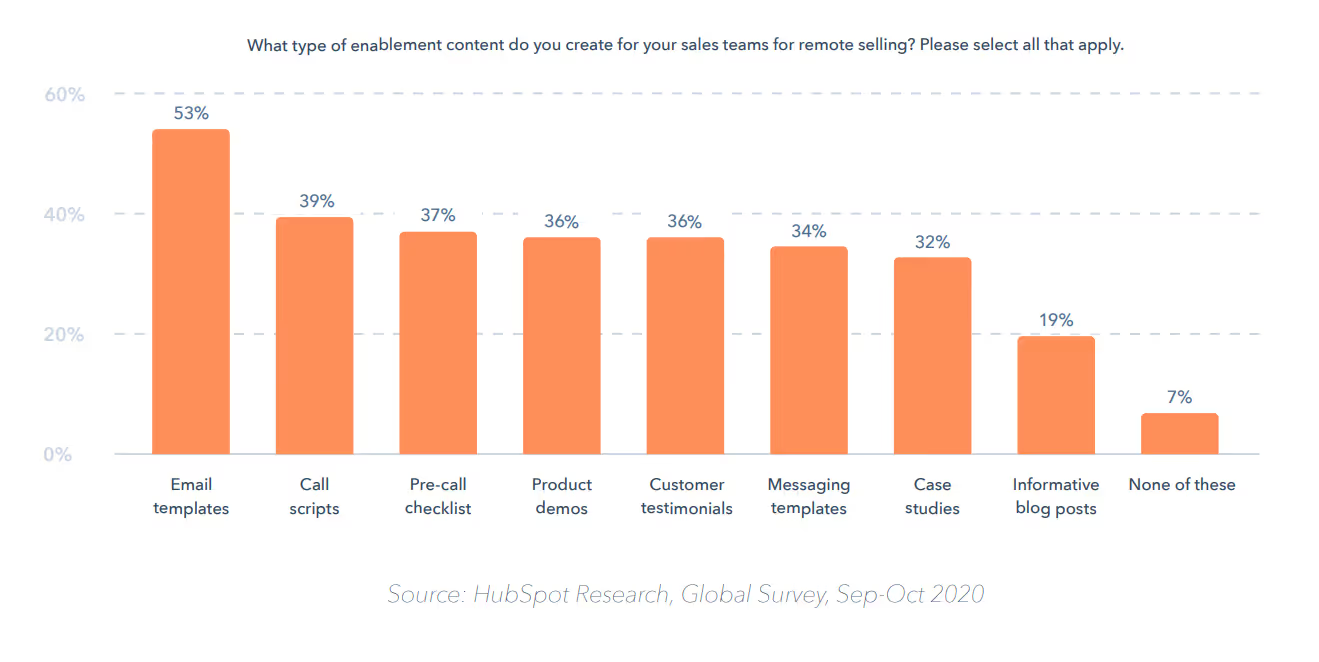
Below we’ll break down the 14 different content types you can create based on your ICP:
These are in-depth narratives that detail a company's solution to a specific client's challenge and the results achieved. By showcasing real-world applications and outcomes, case studies provide tangible evidence of a product's value, helping to build trust and credibility with potential buyers.
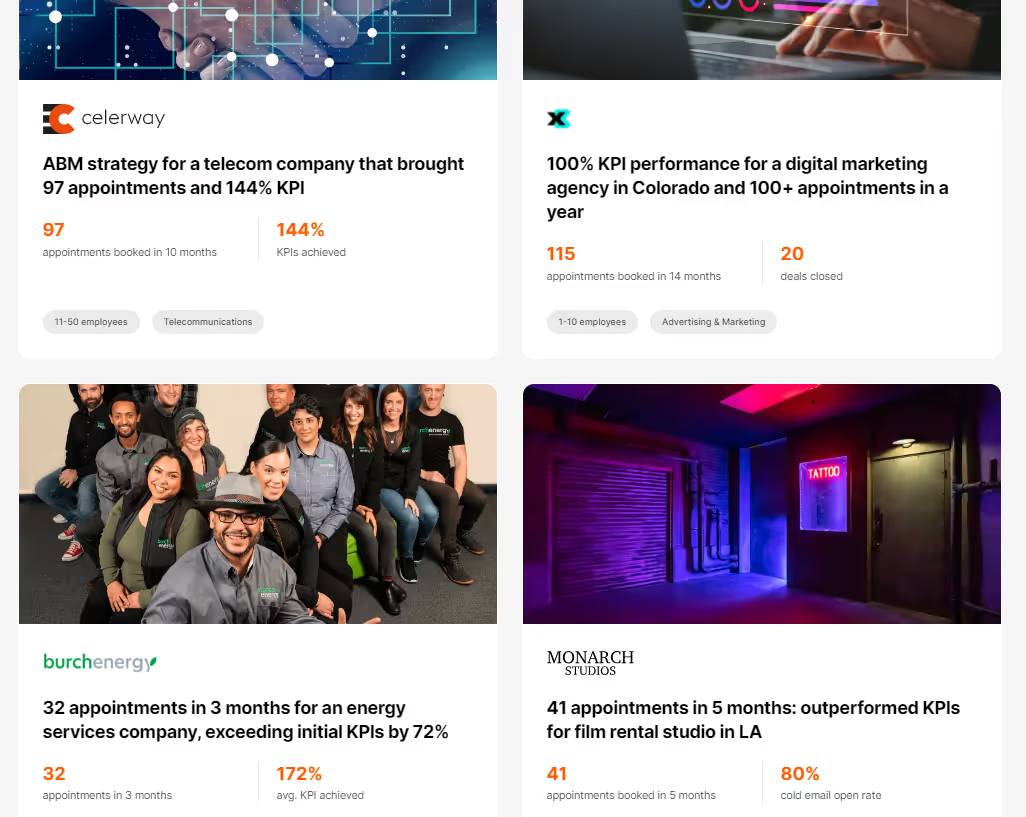
These documents offer a comprehensive overview of a product's specifications, features, and benefits. By providing a clear and concise reference, datasheets enable sales reps and prospects to quickly grasp the product's capabilities, streamlining discussions and reinforcing key selling points.
These are structured guides that outline the sales process, from lead generation to closing. They provide sales reps with best practices, scripts, and strategies tailored to different scenarios, ensuring a consistent and effective approach to selling.
These provide a transparent breakdown of product or service costs, including any tiered pricing or package options. By addressing pricing upfront, sales reps can handle cost-related objections more confidently and help prospects understand the value proposition.

A compilation of frequently asked questions and their answers, FAQ sheets preemptively address common concerns and queries. This not only streamlines the sales conversation but also positions the sales rep as knowledgeable and prepared.
Detailed profiles of target customers, including their demographics, needs, challenges, and buying behaviors. By understanding their audience deeply, sales reps can tailor their pitches more effectively, resonating with the specific pain points and needs of each prospect.
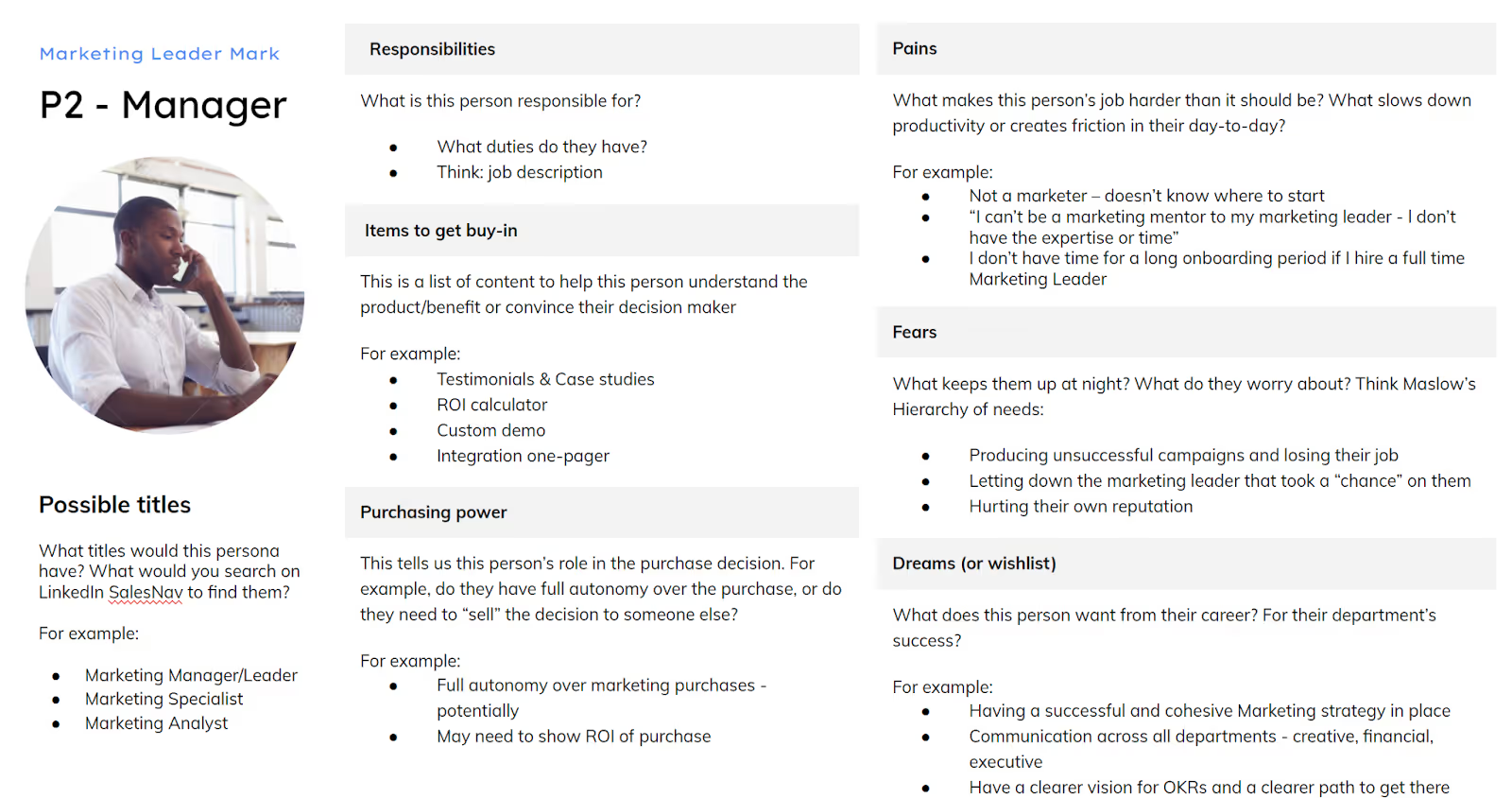
Authentic endorsements from satisfied clients or customers, testimonials act as social proof. They highlight positive experiences and outcomes, reinforcing the product's value and building trust with prospects.
Interactive tools that allow prospects to input data and estimate the potential return on investment from using a product or service. By providing quantifiable metrics, ROI calculators help justify the purchase decision and highlight the product's value.

Pre-recorded sessions showcasing the product in action. They offer flexibility to prospects, allowing them to view the demo at their convenience, and ensure a consistent presentation of the product's features.
Live or animated showcases of a product's functionality and benefits. These interactive demos simplify complex features, making your product more accessible and engaging to prospects.
Ready-to-use email formats tailored to various sales scenarios. They ensure consistent messaging, save time for sales reps, and provide a structured approach to communication throughout the sales journey.
Slide-based content that can include company overviews, product benefits, testimonials, and more. They offer a structured and visually appealing way to convey information, ensuring that sales pitches are comprehensive and engaging.
Concise documents that compare a product or service to its competitors. They arm sales reps with counterarguments and unique selling propositions, enabling them to handle competitive objections confidently.
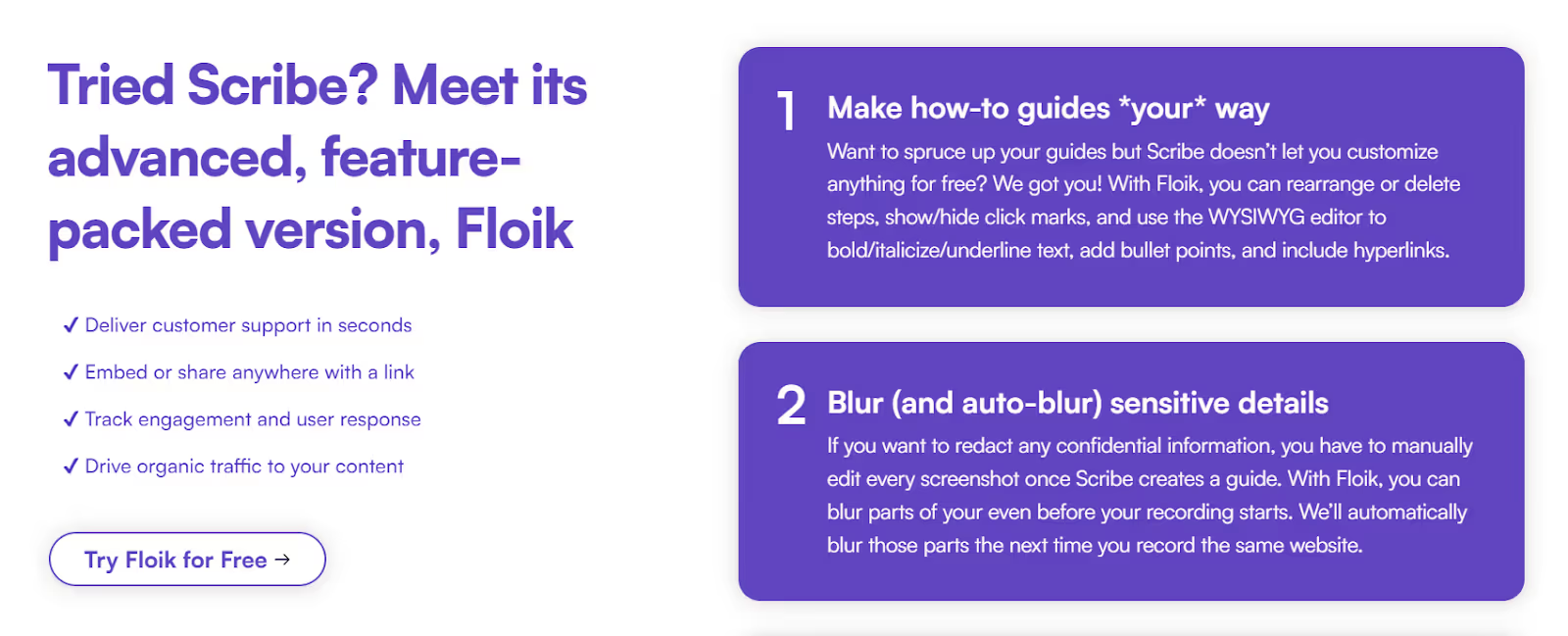
Structured lists of essential questions and topics to address during initial interactions with prospects. They ensure that sales reps gather all the necessary information to understand the prospect's needs and tailor subsequent discussions effectively.

Ready to create winning content for sales enablement? Here are six steps to hit the ground running:
Gaining a deep understanding of your target audience and market dynamics is a good starting point for your content creation process. This foundational knowledge will help you speak your buyers’ language and create content that resonates with them.
Understanding market dynamics also allows you to anticipate shifts in demand and emerging trends to keep your content timely and relevant.
So, connect with your frontline sales reps to get firsthand insights into buyer queries, objections, and feedback. Combine these insights with customer feedback to learn more about what your audience values and expects from your content.
You can also use data analytics tools to track and analyze customer behavior on your website, social media platforms, and other digital touchpoints. This data can reveal preferences and areas of interest to tailor your content more effectively.
Collaboration is key for producing impactful sales enablement content. By pooling knowledge from various sources, especially those on the front lines of customer interaction, you can create content that addresses real-world challenges.
Your sales reps’ firsthand experiences can help you accurately identify your ICP’s:
So, regularly schedule meetings or workshops with your sales team to discuss their observations on these aspects. More importantly, collect their feedback on the content they find most useful.
Cultivate a culture where feedback from sales teams is encouraged and considered a vital step in the content creation process. You can set up dedicated channels for feedback, recognize valuable insights, and showcase how feedback has been implemented in new content.
You can further enhance the quality of your sales enablement content by collaborating with industry experts. This collaboration can elevate the credibility and depth of your content to make it a valuable resource for both your sales team and potential clients.
The goal of every B2B sales enablement content asset is to engage your prospects and guide them through the buying journey. Here are a few best practices to ensure your message hits home in every content piece:
Whether you want to make sales outreach videos or create personalized, self-serve demos, Floik can be your ultimate sidekick for producing sales enablement content.
You can use Floik to create:
We purpose-built Floik for SaaS teams to give their products the spotlight it deserves and effectively engage prospects both before and after purchase. Here’s a quick look at an interactive product demo made with Floik:
.avif)
There’s no set-and-forget approach to producing B2B sales enablement content. You have to constantly review and optimize these materials to best meet your sales reps’ needs and align it with your prospects’ expectations.
Tracking performance metrics can give you a fair idea of which content asset needs a revamp and which one you should use more often. You can track KPIs like page views, time spent on content, click-through rates, conversion rates, etc. to find which content is clicking the most with your prospects.
You can also improve performance by conducting A/B tests before rolling out a resource. Ideally, you can create two or more versions of a content piece and test which version performs the best among your audience.
This split testing method will set you up for success from the start and maximize ROI. It’ll also reveal opportunities to refine your content and make it more engaging.
When you’re selling to discerning B2B buyers, it's not just about what you say, but how you say it.
A consistent brand voice reinforces your brand identity, builds trust, and delivers uniform messaging across all touchpoints. It also cultivates strong brand recall since users would naturally identify your brand when they come across familiar messaging.
You can build this consistency by creating brand voice guidelines. Take inspiration from this example of brand guidelines by Zendesk with details about their brand attributes, voice, logo, typography, style, etc.
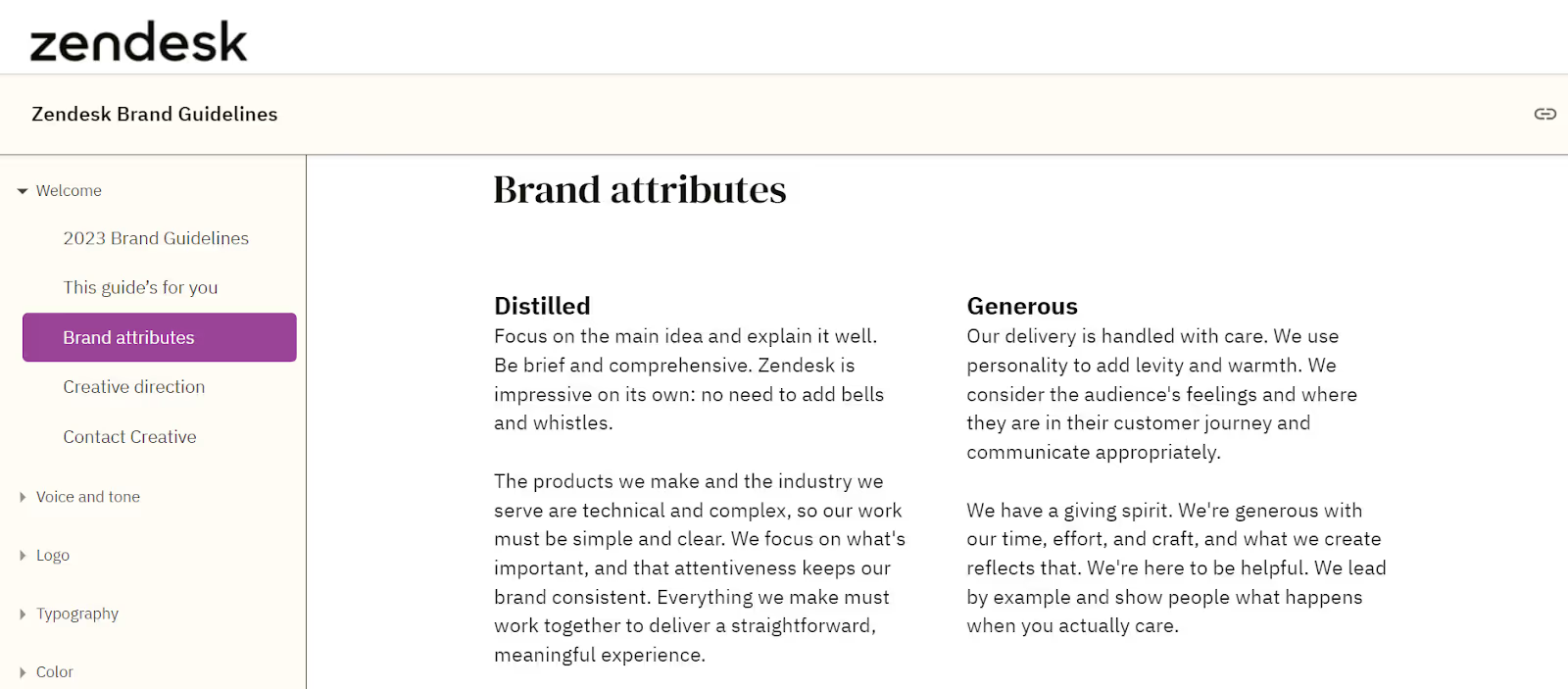
Moreover, for sales enablement content to be effective, it needs to be easily accessible to your sales team. They should be able to quickly find and utilize the right content at the right time, ensuring that their interactions with prospects are timely, relevant, and impactful.
Create a centralized content repository to store all sales enablement materials. You can organize content by categories or tags, such as product type, sales funnel stage, or content format.
Remember to regularly update this repository and ensure that the sales team is trained on how to navigate and retrieve content efficiently.
Sales enablement content is only as effective as the sales team's ability to use it strategically. That’s why you need to conduct regular training sessions to make your team well-versed with the latest content and understand its relevance.
Besides keeping the sales team in the loop of all new content, you should also focus on repurposing high-impact resources across various platforms and formats. This can maximize its reach and deliver a consistent message to appeal to your prospects across all touchpoints.
Here’s a list of some actionable tips to accomplish this:
Now that we’ve answered what and how about B2B sales enablement content, let’s get to the bigger question: who creates sales enablement content?
This content is typically created with a collaborative effort involving multiple departments within an organization. Here's a breakdown of the key players involved in the creation of sales enablement content:
They are often the primary creators of sales enablement content, given their expertise in content creation, branding, and messaging. They produce materials like brochures, whitepapers, case studies, and videos that align with the company's branding and messaging.
While they might not always be the primary content creators, their insights are invaluable. They provide feedback on what content is needed, what's working, and what's not.
They might also create specific materials like sales scripts, email templates, and pitch decks tailored to specific prospects or situations.
They provide in-depth information about product features, benefits, and updates. This team can help create product datasheets, FAQs, and technical specifications.
Their interactions with customers give them insights into common questions, challenges, and feedback. They can contribute to FAQs, troubleshooting guides, and other content that addresses post-sale customer interactions.
Sometimes, organizations collaborate with industry experts, thought leaders, or external agencies to create specialized content. This can include guest blog posts, webinars, or co-authored research reports.
B2B sales enablement content is not just about producing materials; it's about crafting strategic assets that empower sales teams to close deals efficiently.
Your sales reps need tailored content that addresses specific buyer pain points to showcase unique value propositions and streamline the sales cycle. So, use our playbook to create high-impact enablement content to support your sales team and delight buyers at every stage.
Sign up on Floik to get started with the content creation process quickly.